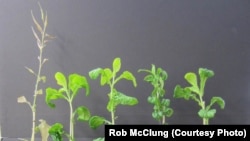Growing enough crops to feed a burgeoning population in a warmer world could depend on a single gene, one that controls the plant's biological clock, according to a new study in the journal Proceedings of the National Academy of Sciences.
"World food supply must increase by 50 to 60 percent by 2050 to feed the population," said Rob McClung, a biologist at Dartmouth College and the study's lead author. "We are worried that the things that we have done to increase agricultural productivity may be becoming exhausted.”
To find new ways to increase productivity, McClung and colleagues looked at plants' circadian rhythm, the process all living things use to synchronize their internal biological clocks with the external world. They identified a gene called GIGANTEA in a common species of field mustard, a plant related to turnips, cabbage and other vegetables.
The gene speeds up or slows down a plant's circadian rhythm, depending on which version of GIGANTEA is expressed. That affects when the plant flowers and how quickly the seedlings develop. It also influences important traits like resistance to extreme cold and high salt.
“We want to be able to predict: If you do this to the clock, you will do this to crop yield," McClung said. It is hoped that the identification of the GIGANTEA gene will give breeders "a molecular tool to try, for example, to introduce increased salt tolerance or increased cold tolerance into a crop plant that we are actually cultivating.”
McClung said that rather than wait for plants to mature to measure the yield, breeders could look at very young seedlings and predict the outcome.
“And so, given that the plant clock is one of the ways, one of the major ways, that the plant tries to synchronize itself with its environment, we think that by manipulating the plant clock, we will be able to make plants that are better in tune with their environment and able to perform more effectively,” he said.
McClung said developing new ways to boost crop yields is critical. Experts have said the expected growth in the production of the world’s major food crops — corn, rice, wheat and soybeans — would not be enough to sustain a global population expected to reach 9.5 billion by 2050.









